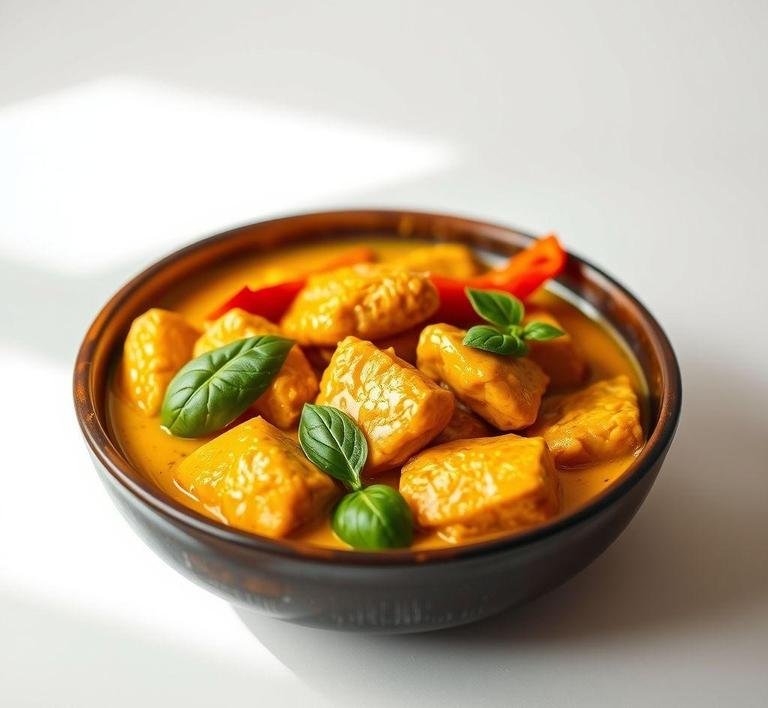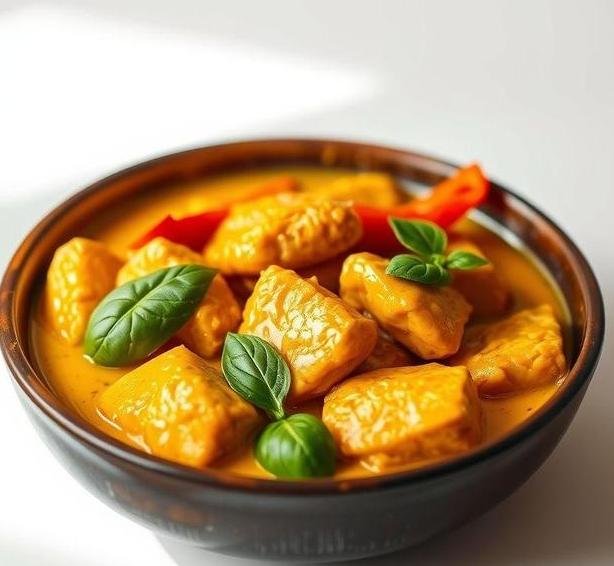Mary Berry, the beloved British baker and television personality, is renowned for her ability to create simple, yet incredibly flavorful dishes that appeal to a broad audience. While her name is most often associated with baking, her culinary expertise extends far beyond cakes and pastries. One of her standout savory creations is her Thai Chicken Curry – a perfect marriage of traditional Thai flavors and the approachable cooking style Mary is known for.
This dish is a vibrant, aromatic curry that offers a delightful balance of rich, creamy coconut milk and the zesty, fresh flavors of lime, lemongrass, and Thai herbs. Mary’s version is accessible without compromising on authenticity, making it ideal for home cooks who want to explore Thai cuisine but may be intimidated by more complex recipes.
What makes this curry unique is its ability to combine the essential elements of Thai food-sweet, sour, salty, and spicy-while remaining relatively easy to prepare. The chicken is tender and succulent, cooked in a fragrant broth that is both comforting and invigorating. Served with a side of steamed jasmine rice or noodles, this curry becomes a complete and satisfying meal.
Mary Berry’s Thai Chicken Curry Recipe
Ingredients Needed

The ingredients for Mary Berry’s Thai Chicken Curry are simple and often available at your local supermarket or grocery store, but some may need to be found at specialty Asian or international food shops. Here’s a breakdown of what you’ll need:
For The Curry Paste
- Red Curry Paste: This is the base of the curry and provides the heat and deep flavor. Red curry paste is made from dried red chilies, garlic, lemongrass, and various spices like cumin and coriander.
- Lemongrass: Fresh or stalk form, it adds a citrusy aroma that is quintessentially Thai. It helps balance the richness of the coconut milk.
- Garlic: A staple in many curries, garlic infuses the dish with an earthy and slightly sweet flavor.
- Ginger: Fresh ginger adds a zingy warmth and depth to the curry.
- Fresh Chilli: For those who enjoy spice, fresh chili can be adjusted to your heat preference.
- Lime Zest: This adds a fragrant citrus note that cuts through the richness of the curry.
For The Curry
- Chicken Thighs: Boneless, skinless chicken thighs are preferred for their moistness and tenderness. The thighs absorb the curry flavors beautifully.
- Coconut Milk: Full-fat coconut milk is the key ingredient that gives the curry its creamy texture and mellow richness.
- Chicken Stock: To thin out the curry, chicken stock is used, adding an additional savory layer.
- Fish Sauce: A key component in Thai cooking, fish sauce brings an umami depth and saltiness to the dish.
- Sugar: Palm sugar is typically used in Thai dishes, but regular sugar works as a substitute. It balances the tartness and heat.
- Lime Juice: Freshly squeezed lime juice adds that essential sour note to complete the Thai flavor profile.
- Fresh Coriander (Cilantro): Used as a garnish, coriander adds a fresh, herbal lift to the finished dish.
For Serving
- Jasmine Rice: The traditional accompaniment to Thai curry, jasmine rice has a subtle floral aroma that complements the dish.
- Chopped Peanuts: Optional, but they add a crunchy texture and nutty flavor to the dish when sprinkled on top.
Equipment Needed
While the ingredients are straightforward, having the right equipment can make the cooking process easier and more enjoyable. Here’s what you’ll need:
- Large Deep Pan or Wok: A sturdy pan or wok is ideal for sautéing the ingredients and cooking the curry. A wok is particularly useful because it distributes heat evenly and allows for better stirring.
- Sharp Knife: For chopping the chicken and vegetables, a sharp chef’s knife will make the prep work more efficient.
- Chopping Board: Ensure you have a clean surface to chop herbs, chicken, and other ingredients.
- Wooden Spoon or Spatula: A wooden spoon is great for stirring the curry without damaging the non-stick surface of your pan.
- Grater/Zester: To get the zest from the lime and grate fresh ginger.
- Lime Squeezer: A tool to make sure you get the most juice out of your limes.
Instructions To Make Mary Berry’s Thai Chicken Curry
Step 1: Prepare The Curry Paste
Start by making the curry paste, which is the foundation of this dish. In a food processor or using a mortar and pestle, combine the red curry paste, lemongrass, garlic, ginger, fresh chili, and lime zest. Blend everything until it forms a smooth paste. If using a mortar and pestle, grind the ingredients together, adding a touch of oil to help bring it together. Set this paste aside.
Step 2: Cook The Chicken
Heat some vegetable oil in a large pan or wok over medium-high heat. Add the chicken thighs (cut into bite-sized pieces) and cook them until browned on all sides. This should take around 5-7 minutes. Once browned, remove the chicken from the pan and set it aside.
Step 3: Prepare The Base
In the same pan, add a bit more oil if necessary, then toss in your freshly made curry paste. Stir it constantly to prevent burning and allow the paste to cook for 2-3 minutes. This releases the aromatic oils and deepens the flavors.
Step 4: Add Liquids
Next, pour in the coconut milk and chicken stock, stirring to combine. Bring the mixture to a simmer and allow it to cook for 10-15 minutes. During this time, the flavors will meld together, and the sauce will start to thicken slightly.
Step 5: Finish The Curry
Once the sauce has reached a desired consistency, return the chicken to the pan. Stir in the fish sauce, sugar, and lime juice. Taste and adjust seasoning if needed. If you like it spicier, you can add extra chili or curry paste at this point.
Step 6: Serve
Serve the curry hot, garnished with fresh coriander and a sprinkling of chopped peanuts if desired. Pair with steamed jasmine rice for a comforting and authentic Thai meal.
Tips And Tricks
- Balance the Flavors: Thai curries are all about balancing sweet, salty, sour, and spicy. If the curry tastes too salty, add a little more sugar or lime juice. If it’s too spicy, add extra coconut milk to mellow the heat.
- Make It Your Own: You can adjust the heat level by varying the amount of fresh chili or red curry paste you use. If you prefer a milder curry, reduce the chili and curry paste.
- Chicken Alternatives: If you’re not a fan of chicken thighs, chicken breast can also work, though it might not be as tender. For a vegetarian version, substitute chicken with tofu or a variety of vegetables like bell peppers, zucchini, and baby corn.
- Curry Paste Storage: If you have leftover curry paste, store it in an airtight container in the fridge for up to a week, or freeze it for later use.
Mary Berry’s Thai Chicken Curry is a flavorful, comforting dish that brings the vibrant and aromatic flavors of Thailand into your kitchen. With a few simple ingredients, you can create a dish that balances heat, sweetness, sourness, and saltiness in perfect harmony. The recipe is versatile and can be adjusted to suit different tastes, making it a great dish for families and dinner guests alike. Whether you’re an experienced cook or a beginner, this curry is sure to impress with its rich depth of flavor and satisfying texture.
Easy Recipe Variations For Mary Berry’s Thai Chicken Curry

Mary Berry’s Thai Chicken Curry is a comforting dish that combines the rich, aromatic flavors of Thai cuisine with the familiar heartiness of chicken curry. It’s a great starting point for experimenting with different ingredients to suit various tastes or dietary preferences. Here are some simple yet creative variations that can add variety to your meal and make it uniquely yours:
-
Vegetarian Version
For a plant-based alternative, you can easily swap the chicken for tofu or vegetables. Tofu, when pressed and cubed, will soak up the curry’s flavors beautifully, offering a satisfying texture and protein-rich substitute. Alternatively, use a medley of vegetables such as bell peppers, carrots, zucchini, and mushrooms. These ingredients will absorb the curry sauce just as well, providing a colorful and hearty dish. For extra flavor, consider adding chickpeas or lentils to make the dish more filling and protein-packed.
-
Seafood Variation
Replace the chicken with prawns, fish fillets, or a combination of seafood like mussels and squid. The delicate nature of seafood pairs well with the rich, coconut milk-based sauce, creating a lighter but equally flavorful dish. Prawns, in particular, cook quickly and are a great option if you’re short on time. If using fish, opt for firm varieties like cod or haddock to avoid them breaking apart in the curry.
-
Spice Level Adjustments
The original recipe may be mild, but if you enjoy heat, you can increase the spice level by adding more fresh chilies, a dash of chili flakes, or even a spoonful of Thai red curry paste. If you want to play around with heat and flavor depth, you could experiment with different types of curry pastes such as green or yellow, each bringing a slightly different balance of spice and fragrance. For a milder version, simply reduce the chili quantities or use sweet red peppers for a gentler flavor.
-
Noodle Or Rice Variation
While the traditional serving for this curry is with rice, consider switching things up by serving it with noodles instead. Thai rice noodles, udon, or even soba can absorb the sauce in unique ways and bring a different texture to the dish. You can also add a dash of fish sauce or soy sauce to the noodles for a more savory base before ladling the curry over them.
-
Herb And Garnish Twists
The garnishes and herbs are crucial for adding freshness and vibrancy. Try topping the curry with fresh coriander (cilantro), Thai basil, or mint for a fragrant finish. For a zesty kick, squeeze fresh lime juice on top just before serving. If you’re looking for a crunchy element, sprinkle roasted peanuts or cashews on top. These simple additions can elevate the dish and bring different textures and flavors to the overall experience.
Storing Leftovers
Like many curries, Mary Berry’s Thai Chicken Curry holds up well to storage, making it a fantastic meal prep option or an easy dinner to enjoy the next day. Proper storage ensures that the flavors continue to develop, giving you an even tastier meal the following day. Here are some tips for storing leftovers:
-
Cool It Properly
Before storing, allow the curry to cool to room temperature. If you put hot food directly into the fridge, it can cause the temperature inside the fridge to rise, affecting the quality and safety of other foods. Aim to cool it within 1-2 hours of cooking to avoid bacteria growth.
-
Use Airtight Containers
Store the curry in airtight containers to retain its moisture and flavors. Glass containers are preferable because they don’t stain, and they help preserve the texture and flavor of the curry. Plastic containers can also work, but be mindful of any lingering smells or stains, especially if your curry has a strong color from the spices.
-
Refrigeration And Freezing
- Refrigeration: The curry can stay fresh in the fridge for about 3-4 days. Simply reheat on the stove or in the microwave, adding a little water or coconut milk to loosen the sauce if it’s thickened. Stir occasionally to ensure even heating.
- Freezing: If you want to store the curry for a longer period, freezing is a great option. Pour the curry into a freezer-safe container, leaving some space at the top for expansion. You can freeze the curry for up to 3 months. When reheating, let it thaw in the fridge overnight and reheat it thoroughly on the stove. Note that the texture of the chicken or tofu might slightly change after freezing, but the flavors will remain robust.
-
Rice Storage
If you’ve got leftover rice, it’s best to store it separately from the curry to maintain its texture. Rice can be kept in the fridge for about 1-2 days. To reheat rice, simply sprinkle some water over it and microwave or steam it until it’s hot. For frozen rice, make sure it’s properly sealed in a freezer-safe bag or container and use it within a month.
What To Eat With Mary Berry’s Thai Chicken Curry?
Mary Berry’s Thai Chicken Curry is already a complete and flavorful meal, but pairing it with the right sides can enhance the experience and bring balance to the dish. Here are a few options to complement your curry:
-
Steamed Jasmine Rice
The classic pairing is steamed jasmine rice, known for its slightly fragrant aroma and fluffy texture. It soaks up the curry sauce wonderfully, making every bite a delight. For a twist, you can try coconut rice, which adds a subtle sweetness that balances out the spiciness of the curry.
-
Thai-style Papaya Salad (Som Tum)
A fresh, zesty papaya salad brings a crunchy, refreshing contrast to the rich and creamy curry. The salad’s combination of shredded green papaya, tomatoes, chili, lime juice, fish sauce, and peanuts provides a tangy and spicy crunch that perfectly offsets the curry’s creaminess.
-
Roasted Vegetables
For a more wholesome meal, consider serving the curry alongside roasted vegetables like sweet potatoes, carrots, or butternut squash. Roasting the vegetables caramelizes their natural sugars, which complements the savory flavors of the curry and adds a touch of sweetness.
-
Thai Spring Rolls
For a lighter side, Thai spring rolls are a fantastic choice. The fresh, crunchy rolls filled with vegetables, rice noodles, and herbs are often served with a tangy dipping sauce that can pair beautifully with the curry. If you’re looking for a heartier option, try fried spring rolls filled with pork or shrimp.
-
Grilled Chicken Skewers
If you’re craving more protein, serve your curry with grilled chicken satay skewers. The smoky, slightly charred flavor of the grilled meat pairs perfectly with the aromatic curry sauce. The peanut dipping sauce typically served with satay also adds a creamy, nutty element to the meal.
Conclusion
Mary Berry’s Thai Chicken Curry is a delightful dish that blends the rich, complex flavors of Thai cuisine with the comforting familiarity of a classic chicken curry. Its versatility makes it a perfect base for a variety of creative twists, whether you’re catering to different dietary needs or simply looking to mix things up. The curry’s adaptability ensures it will appeal to a wide range of tastes, from vegetarian options to seafood variations.
By storing leftovers properly, you can extend the life of this flavorful dish, making it an ideal meal prep option. When paired with the right sides, the curry transforms into a complete feast-whether you opt for something fresh like a papaya salad, or something hearty like roasted vegetables or rice.
Ultimately, Mary Berry’s Thai Chicken Curry is a dish that not only satisfies your taste buds but also invites you to get creative in the kitchen. Whether you’re making it for the first time or trying out a variation, this curry is sure to become a beloved staple in your cooking repertoire.
FAQs
What Ingredients Are Needed For Mary Berry’s Thai Chicken Curry?
To make Mary Berry’s Thai Chicken Curry, you will need chicken breast or thighs, coconut milk, Thai red curry paste, garlic, ginger, onions, chicken stock, fish sauce, lime juice, sugar, fresh coriander, and vegetables like bell peppers and carrots. The recipe also calls for oil for frying and jasmine rice as a side dish.
How Do You Make Mary Berry’s Thai Chicken Curry?
To prepare Mary Berry’s Thai Chicken Curry, start by sautéing garlic, ginger, and onions in a pan with oil until softened. Add the Thai red curry paste and cook for a minute to release its fragrance. Next, stir in the chicken, followed by the coconut milk, chicken stock, fish sauce, lime juice, and sugar. Simmer the curry until the chicken is cooked through and the flavors are well blended. Finally, add the vegetables and cook until tender. Serve hot with jasmine rice and garnish with fresh coriander.
Can I Substitute The Chicken For Another Protein In Mary Berry’s Thai Chicken Curry?
Yes, you can easily substitute chicken with other proteins like tofu, prawns, or beef. If using tofu, press it first to remove excess moisture and cut it into cubes. For prawns, add them towards the end of the cooking process as they cook quickly. For beef, you may want to choose tender cuts like sirloin or fillet, slicing them thinly to ensure they cook evenly in the curry.


